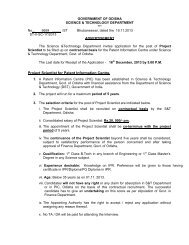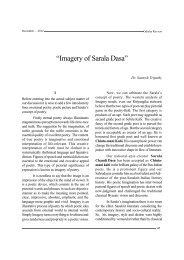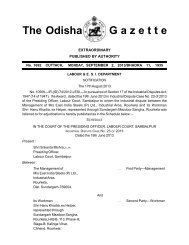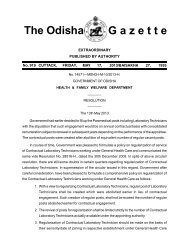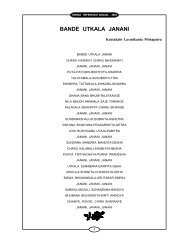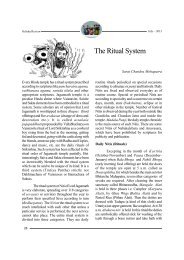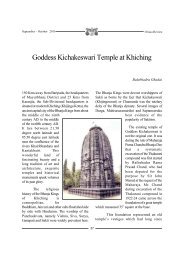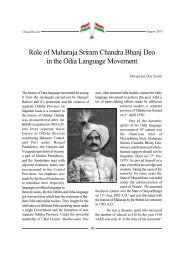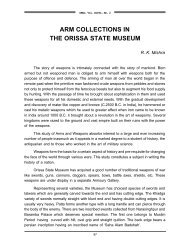Create successful ePaper yourself
Turn your PDF publications into a flip-book with our unique Google optimized e-Paper software.
<strong>Orissa</strong> Review * February - March - 2009<br />
<strong>The</strong> <strong>Holy</strong> <strong>Land</strong> <strong>of</strong> <strong>Hindus</strong> - <strong>Orissa</strong><br />
Pramoda Chandra Pattanayak<br />
Since the period <strong>of</strong> remote past the state <strong>of</strong> <strong>Orissa</strong>,<br />
alias Utkal, alias Kalinga alias Odisa has been<br />
holy place for <strong>Hindus</strong>. <strong>The</strong> life is said to be<br />
incomplete for <strong>Hindus</strong> without touching the dust<br />
<strong>of</strong> this holy land according to Hindu Philosophy.<br />
<strong>The</strong> nomenclature <strong>of</strong> the state as 'Utkal' was<br />
derived probably from Sanskrit word 'Utkarsha'<br />
meaning the best. But Dr. Mayadhar Mansingh<br />
opined differently which may also be correct.<br />
According to Dr. Mansingh the name Utkal was<br />
derived from the tribe <strong>of</strong> the same name, then<br />
inhabited in the State. Dr. Mansingh based his<br />
opinion referring to "Raghu Vansa" <strong>of</strong> the poet<br />
Kalidas wherein the great poet described that the<br />
Utkalas guided the Army <strong>of</strong> Raghu after the<br />
victory <strong>of</strong> Bengal across the river Kapisa, now in<br />
the district <strong>of</strong> Midnapore <strong>of</strong> West Bengal and led<br />
the army to the land <strong>of</strong> Kalingas in the southern<br />
part. <strong>The</strong>n the army took shelter in the cool forest<br />
<strong>of</strong> Mahendra, now within the territory <strong>of</strong> the state<br />
<strong>of</strong> <strong>Orissa</strong>. But this tribe <strong>of</strong> Utkal lost their political<br />
identity, the reason <strong>of</strong> which are obscure and<br />
history appears to be silent on this score. Of course<br />
it is logical to consider that this tribe has been<br />
overpowered by the Kalingas in course <strong>of</strong> time.<br />
<strong>The</strong> Kalingas were well known in and outside the<br />
country not only for their bravery but also for their<br />
daredevil spirits and overseas trades etc. Further,<br />
for the information <strong>of</strong> readers, in the epic battle<br />
<strong>of</strong> Mahabharat the king <strong>of</strong> Kalingas with his great<br />
numbers <strong>of</strong> war-elephants supported Duryodhan<br />
his son-in-Law. This caused a lot <strong>of</strong> worries in<br />
the camps <strong>of</strong> his opponent. Though prehistoric, it<br />
is an authentic document in support <strong>of</strong> bravery <strong>of</strong><br />
the Kalingas and prosperous period <strong>of</strong> the state.<br />
But the darkest period for the state began on the<br />
enforcement <strong>of</strong> the Treaty <strong>of</strong> Allahabad in 1975<br />
by which Lord Clive obtained the Dewanship <strong>of</strong><br />
Bengal, Bihar, and <strong>Orissa</strong> from the then weak<br />
Moghul Emperor reducing the territory <strong>of</strong> the<br />
state. By the time the state was occupied by<br />
Marathas till 1803 before it was taken over by<br />
the British Administration. Marathas got only <strong>of</strong><br />
Cuttack (not entire state) from the Nawab <strong>of</strong><br />
Bengal, Ali Verdi Khan in 1751 in condition that<br />
they should not cause any trouble in the borders<br />
<strong>of</strong> Bengal. It seems the people in the southern<br />
borders <strong>of</strong> Bengal were harassed by the frequent<br />
attacks by Marathas. In addition to the province<br />
<strong>of</strong> Cuttack Marathas were getting an amount <strong>of</strong><br />
twelve lakh rupees annually as a pocket money<br />
in lieu <strong>of</strong> stopping their menacing activities and<br />
collection <strong>of</strong> revenue from <strong>Orissa</strong>. This pocket<br />
money was also continued by Lord Clive as<br />
Dewan <strong>of</strong> the three States. But the historians differ<br />
on the above account. While some historians<br />
support the above account others differ. <strong>The</strong>y say<br />
that by paying this handsome amount Aliverdi<br />
46
<strong>Orissa</strong> Review * February - March - 2009<br />
Khan was able to knock out the area north <strong>of</strong><br />
river Suvernarekha upto the river Ganga and<br />
annexed it to Bengal leaving Marathas only area<br />
south <strong>of</strong> Suvernarekha as province <strong>of</strong> Cuttack.<br />
<strong>The</strong> state lost this area to this day. But the fact is<br />
that the area <strong>of</strong> the state was from the river Ganga<br />
in the north to the Godavari in the south when<br />
occupied by Afgans and later by Moghuls.<br />
At some point <strong>of</strong> period in the past Kalingas<br />
were wiped out by a barbaric tribe, the Odras,<br />
probably drawn from the western side who<br />
gradually dominated in the area and contributed<br />
to the identity for the state so far as the language,<br />
life pattern ,pr<strong>of</strong>ession and cultural aspects are<br />
concerned. <strong>The</strong> descendants <strong>of</strong> Odras lived upto<br />
the present era in the name <strong>of</strong> Odas, with their<br />
age old agricultural practices, the Odas formed<br />
the backbone <strong>of</strong> the state. <strong>The</strong>y used to produce<br />
the primary need <strong>of</strong> the life, the food grains . This<br />
peasantry class with their habit <strong>of</strong> hard labours<br />
used to produce grains more than their<br />
requirements. Thus being a surplus state was<br />
generous to supply to other neighbouring states<br />
at the time <strong>of</strong> their scarcity. <strong>The</strong> lives and activities<br />
<strong>of</strong> this peasantry class have been vividly described<br />
by the master craftsman <strong>of</strong> the language <strong>of</strong> the<br />
yester years, Fakir Mohan Senapati in many <strong>of</strong><br />
his writings <strong>of</strong> which "Chhaman Athaguntha"is a<br />
classic <strong>of</strong> all time. Of course before Fakir Mohan,<br />
Sarala Das had done a good accounts <strong>of</strong> the<br />
peasantry class <strong>of</strong> the state in his epical volumes<br />
<strong>of</strong> Mohabharat.<br />
This is how the name <strong>of</strong> the state at different<br />
periods has been changed from Utkal to Kalinga<br />
and Kalinga to Odra (Udradesa) and finally from<br />
Odra to Odisa. Odisa became <strong>Orissa</strong> probably<br />
during colonial period. Despite the present name<br />
<strong>of</strong> the state, the people, specially the high pr<strong>of</strong>ile<br />
group, have an inclination towards the old names.<br />
That is why the first University <strong>of</strong> the state was<br />
named as Utkal University. <strong>The</strong> name <strong>of</strong> the state<br />
finds its place in our National anthem as Utkal.<br />
<strong>The</strong> Stadium <strong>of</strong> Bhubaneswar is named as Kalinga<br />
Stadium so on and so forth. <strong>The</strong>re is also a move<br />
to change the name <strong>of</strong> the state from <strong>Orissa</strong> to<br />
Utkal by some group <strong>of</strong> people which <strong>of</strong> course<br />
did not get momentum in want <strong>of</strong> wide support.<br />
Now some people like to write Odisa instead <strong>of</strong><br />
<strong>Orissa</strong> in the manner <strong>of</strong> Mumbai to Bombay,<br />
Bangaluru to Bangalore, Kolkata to Calcutta etc.<br />
But <strong>of</strong>ficially the name <strong>of</strong> the state continues to<br />
be <strong>Orissa</strong> till to day.<br />
<strong>The</strong> state was called differently at different<br />
periods in the past but the boundary used to be<br />
from Ganga to Godabari. <strong>The</strong>re is no dispute over<br />
this point. It seems the king <strong>of</strong> <strong>Orissa</strong>, Mukunda<br />
Harichandan (1559-1568) had undertaken a<br />
massive project <strong>of</strong> excavating a canal from the<br />
river Ganga at Triveni, presently in the district <strong>of</strong><br />
Midnapore <strong>of</strong> West Bengal which was then within<br />
the territory <strong>of</strong> this state. A good account <strong>of</strong> this<br />
is found in history that the king Harichandan himself<br />
was supervising the project at Triveni away from<br />
Cuttack, his royal Headquarter. Taking full<br />
advantage <strong>of</strong> his absence in the headquarter, the<br />
Afgan Muslim ruler <strong>of</strong> Bengal could successfully<br />
organize a coup to occupy the state. Thus the<br />
state faced a disastrous fate for its people who<br />
resisted all the previous coups <strong>of</strong> Muslims during<br />
preceding three centuries from south and north<br />
as well. This was the first time the state came<br />
under a Muslim ruler after the death <strong>of</strong> vanquished<br />
king Harichandan. In spite <strong>of</strong> the victory <strong>of</strong> the<br />
Afgans in the battle field, the ruler could not<br />
subdue the Oriyas who continued the guerilla<br />
fighting showing the extreme patriotism for their<br />
Motherland. This led to anarchism for a period<br />
<strong>of</strong> over twenty years causing lot <strong>of</strong> sufferings for<br />
themselves. During this period the mighty Army<br />
<strong>of</strong> emperor Akbar under General Jai Singh came<br />
to <strong>Orissa</strong> and drove away the Afgans from this<br />
47
<strong>Orissa</strong> Review * February - March - 2009<br />
land. But Jai Singh was so, overwhelmed with<br />
the bravery <strong>of</strong> the Oriyas and their cultural activities<br />
that he did not want to rule the state and simply<br />
imposed a token amount in recognition <strong>of</strong> his<br />
victory. At the end <strong>of</strong> the period <strong>of</strong> anarchism the<br />
state was gradually overcoming the depression<br />
when people assembled and elected a person<br />
named Ramei Routra, son <strong>of</strong> Daneye Bidyadhar<br />
as their chief. Rame Routra was then elevated to<br />
the rank <strong>of</strong> Maharaja <strong>of</strong> <strong>Orissa</strong> (AD.1580) and<br />
renamed as Ramachandra Rao and this also got<br />
the approval <strong>of</strong> General Jai Singh. Incidentally<br />
emperor Akbar had his tour to this state in search<br />
<strong>of</strong> royal interest. But like General Jai Singh he<br />
was too much impressed to find this holy land,<br />
especially, Bhubaneswar with its numerous<br />
temples and their architecture, knowledgeable<br />
Brahmin Pandits and their sacred activities and<br />
characters etc. He finally decided not to interfere<br />
in their affairs and left the region to the native<br />
princes. Midnapore was made northern boundary<br />
<strong>of</strong> <strong>Orissa</strong> and <strong>Orissa</strong> was made a Seharate Suah<br />
under Moghul Empire with five divisions such as<br />
(i) Jaleswar having Midnapore, Baukura and a<br />
part <strong>of</strong> Balasore. (ii) Bhadrak - with lower<br />
Bhadrak and northern part <strong>of</strong> Cuttack.<br />
(iii) Cuttack with rest part <strong>of</strong> Cuttack and entire<br />
Puri district. (iv) Kalinga covering Ganjam and<br />
Srikakulam districts. (v) Rajmahendri covering up<br />
area between Godavari and Krishna. As such the<br />
state's territory extended from the Ganga in the<br />
North to the Godavari in the South is not an<br />
imagination <strong>of</strong> somebody but a history.<br />
As the rivers Ganga and Godavari even the<br />
river Baitarani are considered holy by <strong>Hindus</strong><br />
(even by a lot <strong>of</strong> non <strong>Hindus</strong>), the land locked in<br />
between the rivers washed by the holy water <strong>of</strong><br />
the above rivers is considered as holy. Further<br />
Puri is washed by the waves <strong>of</strong> blue water <strong>of</strong> Bay<br />
<strong>of</strong> Bengal the Mahodadhi. It is believed in Hindu<br />
philosophy that people become free <strong>of</strong> their sins<br />
either <strong>of</strong> commission or omission, on touching the<br />
dust <strong>of</strong> this holy land.<br />
This holy land has, therefore, attracted<br />
many great men and philosophers since prehistoric<br />
period to this time. It seems Pandavas<br />
accompanied with their common wife, Draupadi<br />
visited this land. Out <strong>of</strong> many dignitaries and<br />
Mahatmas (great souls) who visited this holy land<br />
Chaitanya, Shankar, Ramanuja, Madhav, Ballav,<br />
Nanak, to name the few. During movement <strong>of</strong><br />
independence <strong>of</strong> India, Mahatma Gandhi decided<br />
to start his Dandi Jatra in <strong>Orissa</strong> from the holy<br />
city <strong>of</strong> Jagannath and moved in the rural <strong>Orissa</strong><br />
upto the borders in the North. <strong>The</strong> last but not<br />
the least, Ashok the Great came to rule this land<br />
but the magic <strong>of</strong> the holy land converted him from<br />
Chandasoka to Dharmasoka by the bravery and<br />
patriotism <strong>of</strong> the people <strong>of</strong> <strong>Orissa</strong>.<br />
On the above account, this holy land has<br />
attracted the pilgrims from far and near and<br />
Srikhetra (Puri) is the hub throughout the year.<br />
But the Car festival is the special attraction which<br />
draws people <strong>of</strong> the country and abroad<br />
irrespective <strong>of</strong> caste, creed and colour.<br />
Pramoda Chandra Pattanayak lives at Plot No.678,<br />
Laxmisagar, Bhubaneswar.<br />
48



